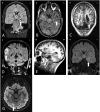Getting the best outcomes from epilepsy surgery
- PMID: 29534299
- PMCID: PMC5947666
- DOI: 10.1002/ana.25205
Getting the best outcomes from epilepsy surgery
Erratum in
-
Erratum.Ann Neurol. 2018 Jun;83(6):1205. doi: 10.1002/ana.25259. Ann Neurol. 2018. PMID: 30133830 Free PMC article. No abstract available.
Abstract
Neurosurgery is an underutilized treatment that can potentially cure drug-refractory epilepsy. Careful, multidisciplinary presurgical evaluation is vital for selecting patients and to ensure optimal outcomes. Advances in neuroimaging have improved diagnosis and guided surgical intervention. Invasive electroencephalography allows the evaluation of complex patients who would otherwise not be candidates for neurosurgery. We review the current state of the assessment and selection of patients and consider established and novel surgical procedures and associated outcome data. We aim to dispel myths that may inhibit physicians from referring and patients from considering neurosurgical intervention for drug-refractory focal epilepsies. Ann Neurol 2018;83:676-690.
© 2018 The Authors Annals of Neurology published by Wiley Periodicals, Inc. on behalf of American Neurological Association.
Figures



References
-
- Wiebe S, Blume WT, Girvin JP, Eliasziw M. A randomized, controlled trial of surgery for temporal‐lobe epilepsy. N Engl J Med 2001;345:311–318. - PubMed
-
- Engel JJ, Wiebe S, French J, et al. Practice parameter: temporal lobe and localized neocortical resections for epilepsy: report of the Quality Standards Subcommittee of the American Academy of Neurology, in association with the American Epilepsy Society and the American Association of Neurology. Neurology 2003;60:538–547. - PubMed
-
- Berg AT, Langfitt J, Shinnar S, et al. How long does it take for partial epilepsy to become intractable? Neurology 2003;60:186–190. - PubMed
Publication types
MeSH terms
Grants and funding
LinkOut - more resources
Full Text Sources
Other Literature Sources
Medical

